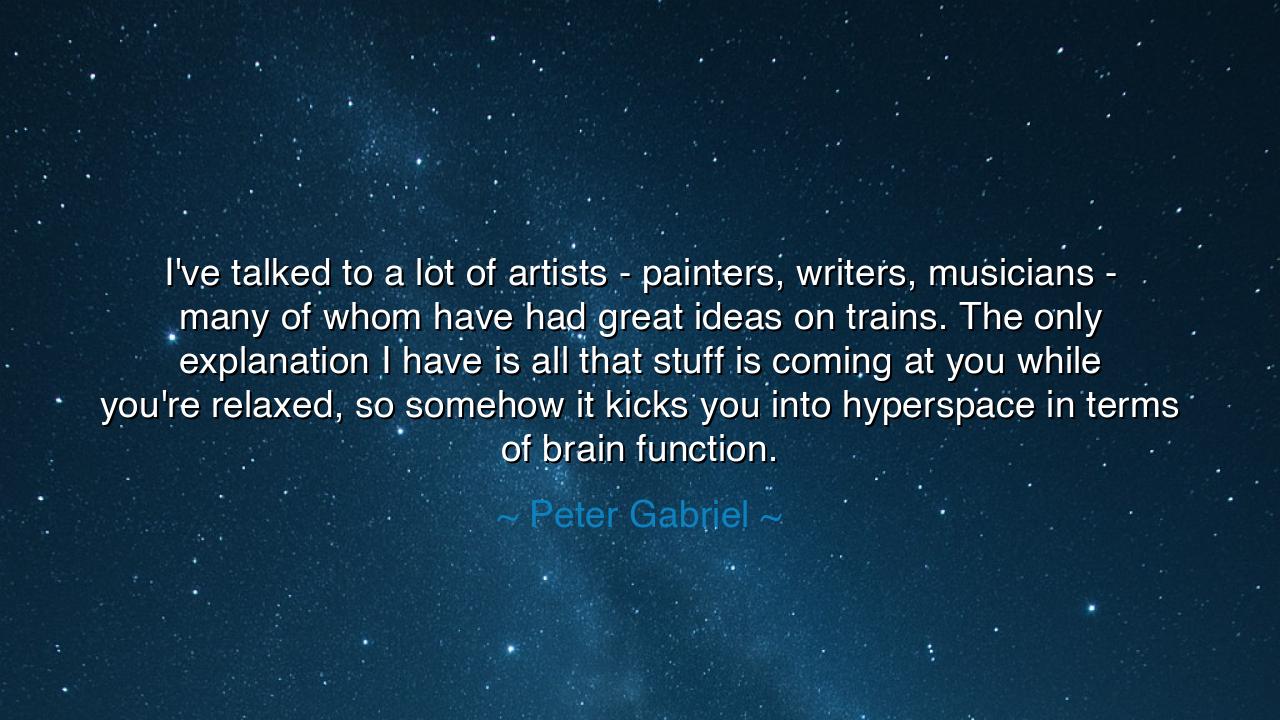
I've talked to a lot of artists - painters, writers, musicians -
I've talked to a lot of artists - painters, writers, musicians - many of whom have had great ideas on trains. The only explanation I have is all that stuff is coming at you while you're relaxed, so somehow it kicks you into hyperspace in terms of brain function.






“I've talked to a lot of artists—painters, writers, musicians—many of whom have had great ideas on trains. The only explanation I have is all that stuff is coming at you while you're relaxed, so somehow it kicks you into hyperspace in terms of brain function.” — Peter Gabriel
In these thoughtful and wonder-filled words, Peter Gabriel, musician, visionary, and seeker of the inner rhythms of creation, speaks not merely of trains and travel, but of the mysterious alchemy of inspiration. His observation captures one of the oldest truths known to poets and sages alike: that the human mind is most brilliant not when it strains, but when it surrenders. When he speaks of “great ideas on trains,” he is describing that sacred state between movement and stillness—when the body journeys through space, yet the mind drifts freely through eternity. In that state, the noise of effort quiets, and the deep music of the universe can be heard.
The origin of this reflection lies in Gabriel’s own creative life. As an artist who has long explored the borders between technology and spirit, he understood that inspiration cannot be summoned by command—it must be invited. On the rushing train, surrounded by rhythm and motion, the senses are engaged, but the will is at rest. The landscape passes like a dream, and the mind begins to dance with its own reflections. The world streams by in fragments of color and sound, while deep within, connections spark and fuse. Thus, in that paradox of motion and calm, the artist’s mind enters hyperspace—that hidden dimension where ideas are born whole, shining, and alive.
The ancients knew this truth well. The philosopher Archimedes, upon stepping into his bath, cried “Eureka!”—not in the laboratory, but in a moment of leisure. The great Lao Tzu wrote that the sage achieves through stillness, and that “by letting go, all things are done.” Even Einstein, centuries later, confessed that his insights came not from effort but from wonder—when walking, dreaming, or sailing under quiet skies. It is the same mystery Peter Gabriel names: that relaxation unlocks revelation, that the universe speaks clearest when the mind stops shouting long enough to listen.
The image of the train itself is symbolic. It represents the journey of existence—the forward motion of life through an ever-changing landscape. Within its gentle rhythm, there is order without control, movement without strain. The artist, seated by the window, becomes both observer and participant, passing through the world and watching it pass through him. In this harmony between outer motion and inner stillness, the mind opens its gates, and imagination flows like light across glass. Every sound—the clatter of wheels, the hum of the rails—becomes part of an unseen symphony, stirring the soul into creative awakening.
This wisdom stretches beyond the artist’s realm. Every human being, in some way, seeks inspiration—solutions to problems, clarity of purpose, or simply the courage to see anew. Yet most seek it by force, chasing ideas with clenched minds. Peter Gabriel reminds us that creativity blossoms when we stop chasing. Whether on a train, a walk, or in the quiet of evening, the act of stepping back—of allowing life to flow through us—awakens powers we did not know we possessed. The subconscious, freed from pressure, begins to weave connections invisible to our waking effort. It is in this surrender that the extraordinary often emerges.
Consider also that Gabriel’s “hyperspace of brain function” is not merely poetic, but profoundly human. When relaxed, the mind enters a state modern thinkers call flow, where awareness sharpens, time softens, and insight strikes like lightning. In ancient terms, it is the moment when the muse descends—when inspiration ceases to be personal and becomes cosmic. It is not the mind thinking, but the universe thinking through the mind. The artist, then, becomes a vessel, and the train, a chariot carrying him into the unseen realms of creation.
Thus, the lesson is clear and eternal: to create, one must learn to let go. Do not force inspiration; prepare for it. Fill your mind with beauty, your heart with curiosity, and your life with motion—but do not clutch at ideas. When the moment comes, they will find you, as the horizon finds the traveler. Make room for stillness amid your movement, and allow the rhythm of life itself to awaken the song within you.
So remember this, O seeker of the creative flame: relaxation is not idleness, but readiness. The artist on the train is not escaping the world—he is listening to it, harmonizing with its pulse. Let your thoughts drift, your senses awaken, and your spirit open to the vast flow of existence. For when you cease to strive, the universe begins to speak—and in that moment, like Peter Gabriel’s vision, your mind, too, shall enter the hyperspace of inspiration, where the soul and the cosmos meet in timeless creation.






AAdministratorAdministrator
Welcome, honored guests. Please leave a comment, we will respond soon